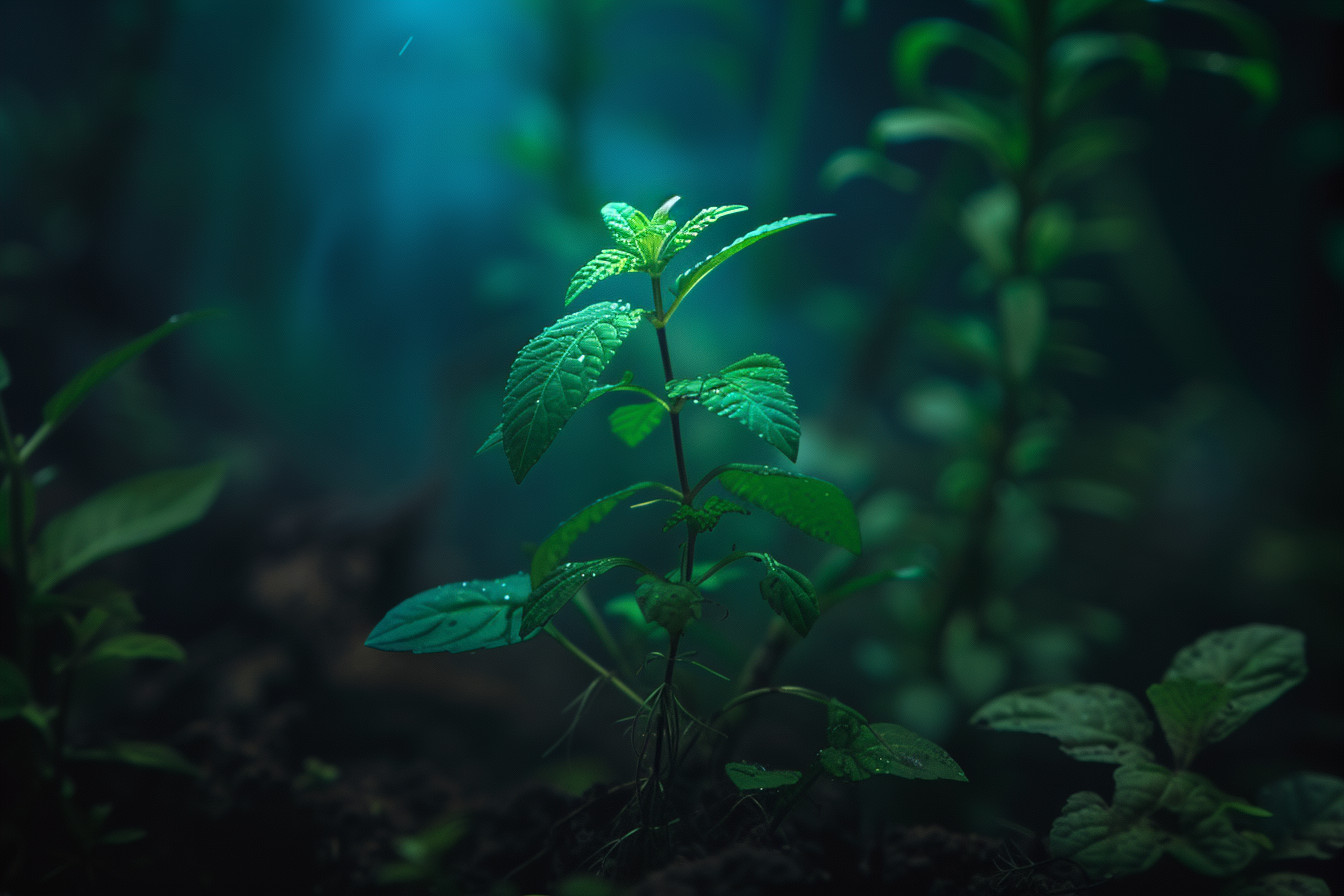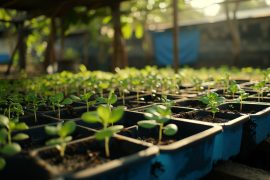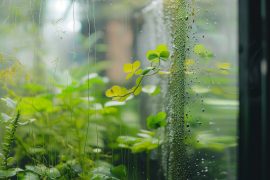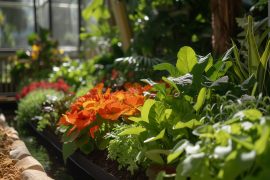Let me dive straight into something that’s close to my heart: the impact of temperature on aquaponic systems. It might seem like a niche topic, but hear me out—it’s fascinating and so crucial if you’re dabbling in or devoted to this sustainable method of growing both fish and plants together. Understanding how temperature plays its part is key; too hot or too cold can throw off your entire system.
I’ve learned through trial and error (and trust me, there were plenty of errors) just how sensitive these ecosystems are. The right warmth ensures our finned friends thrive while providing an ideal environment for plant roots—basically hitting two birds with one stone—or, should I say, feeding two mouths with one ecosystem?
Temperature affects everything from the oxygen levels in water, which fish dearly need, to nutrient uptake by plants.
Now let’s get technical, but keep it accessible because nobody wants jargon overload! Aquaponics hinges on symbiosis between aquatic animals and hydroponically grown crops—a balance upset easily by fluctuating temperatures outside their comfort zones. You see, different species demand specific ranges where they perform best when eating.
The Importance of Temperature in Aquaponics
Diving into the world of aquaponics is like discovering a hidden gem that fuses the tranquility of gardening with the rhythmic flow of aquatic life. Imagine this serene environment where plants and fish live in harmony, supporting one another. It sounds idyllic, right? However, maintaining this balance requires understanding various factors, notably temperature.
Temperature plays a crucial role in aquaponic systems; think about it as setting up an outdoor tent for camping: too hot or too cold can make your adventure either unpleasant or memorable for all the wrong reasons! For both fish and plants to thrive together:
- Fish are quite picky when it comes to water conditions because their metabolism is directly influenced by temperature.
- On the top side, there are our green buddies who depend on specific temperatures, not only at the air level but at root zone levels too!
Here’s something interesting I found out during my own dabbling with aquaponics—each plant species has its own unique ‘comfort zone’. Too cold? They might slow down nutrient uptake, leading to stunted growth. But get things just warm enough without going overboard. Voila! You’ve got your own robust health expressing itself through every leaf.
Moreover, let me tell you about balancing acts, since keeping everyone comfortable isn’t always straightforward. We’re dealing essentially cross-species matchmaking here after all. Remember, optimal ranges differ significantly across flora and fauna, so monitoring and adjusting have become key endeavors.
Now picture early mornings spent checking pH levels and ensuring heaters and chillers are set correctly. This meticulous attention pays off. Nature hums along contentedly under watchful eyes. Eventually yielding fresh produce even outside standard growing seasons
How very gratifying, no?
So while number tables seem daunting at first, they unravel magical elements behind the scenes. By allowing precise control and customization, they witness remarkable resilience and adaptability within a small ecosystem. Perhaps a testament to how interconnected nature often lies in the fine details, we tend to tune out the daily hustle and bustle. Isn’t amazing to ponder upon once in awhile
Optimal Temperature Range for Aquaponic Systems
Finding the sweet spot when it comes to temperature in aquaponic systems is like tuning a guitar. Get it just right, and everything harmonizes beautifully—your plants thrive while fish paddle contentedly in their aquatic home. Let’s explore why hitting that optimal temperature range isn’t only good practice; it’s crucial.
Each element of an aquaponic system, from leafy greens to lively tilapia or serene koi, has its own Goldilocks zone where conditions are “just right.” For most setups aiming at vegetable production partnered with warm-water fish species, temperatures between 70°F (21°C) and 86°F (30°C) achieve this harmony best. Plants get enough warmth without wilting away under too much heat, while the water remains invitingly tepid for our finned friends.
Here’s a brief table summarizing ideal ranges:
| Component | Ideal Temperature Range |
|---|---|
| Warm-Water Fish | 77°F–86°F (25°C–30°C) |
| Leafy greens and herbs | Above 60° F (~15.5° C)+ |
Venturing outside these zones invites trouble into paradise—one might find themselves wrestling algae blooms outcompeting nutrients as temperatures ascend past tolerable levels or observe sluggish plant growth if things swing chilly.
Throwing back to personal experience here: I once had my system sneak up on me heading north of those golden numbers during a particularly blistering summer stretch. Let’s say learning about thermal management became priority number one really fast!
So how do we keep balance? Passive cooling strategies such as shade cloaks help shield sun-sensitive components from midday ire, whereas insulating tanks can buffer chillier night air kisses, keeping everyone cozy come moonrise.
Remember, folks, every garden reflects nature’s grand design, but within each closed loop lie unique variables—your local climate. Outdoor shading vs. indoor lighting scenarios all play roles large and small, steering us towards success story horizons.
The Effects of High Temperatures on Aquaponic Systems
Diving into the world of aquaponics, we often marvel at its elegance and sustainability. This method combines fish farming with soilless plant cultivation, offering a harmonious garden ecosystem right in our backyards or urban spaces.
But as much as it’s an innovative approach to gardening and food production, aquaponics isn’t free from challenges—especially when temperatures start rising.
When summer hits full throttle and the mercury climbs higher than expected, our thriving ecosystems can begin to struggle. High temperatures spell trouble for both components of these systems; aquatic life and plants alike face significant stress under excessive heat conditions.
Fish are particularly sensitive creatures whose metabolic rates increase with temperature; they need more oxygen but find less available since warm water holds lower oxygen levels than cool water does.
If not managed well, this phenomenon called thermal shock could lead directly into perilous waters, affecting their growth, health, and even mortality rates during extreme heat spells! Here’s what happens:
- Oxygen depletion: As mentioned, warmer waters carry
less dissolved oxygen, which is vital for fish survival.
| Fish species | Optimal Temperature Range (°F) |
|---|---|
| Tilapia | 82–86 |
| Trout | 50–65 |
Plants, too, aren’t immune to high temperature effects within aquaponic setups because each variety has its own comfort zone, beyond which growth starts shutting down nutrient absorption and becomes ineffective.
Leaves might wilt or show signs such as scorching around edges, indicating distress due to direct solar exposure coupled with air that feels like walking through soup!
Then comes nitrifying bacteria—unsung heroes turning ammonia waste products into usable nitrogen for necessary healthy crop development. These microscopic workers have optimal operating ranges above and below productivity drops, meaning the entire balanced equation is thrown into chaos.
It boils down to a lack of essential nutrients being converted, thereby slowing or halting altogether.
In dealing head-on, ensuring those highs won’t prove devastating involves proactive measures. Measures of keeping the system shaded and circulating plenty of fresh air while monitoring pH closely pay dividends. preventing fragmented habitat Adjustments include:
- Installing shade cloth structures
- Increasing aeration using pumps and aerators
Strategies for Managing High Temperatures in Aquaponics
Battling the blaze of high temperatures in an aquaponic system can feel a bit like trying to keep your cool during a scorching summer day—challenging but not impossible. Here, I’ll share some strategies that become my go-to over the years.
First up is shade. It might seem simple, yet it’s incredibly effective. Imagine you’re lounging under a tree on a hot day; plants and fish need that same relief from direct sunlight. Using shade cloths can reduce water temperature dramatically by preventing excess heat from penetrating into the system—a lifesaver when degrees start creeping upwards.
Then there’s something about circulating air that just works wonders. A well-placed fan or two around your aquaponic setup isn’t only good for cooling down human bystanders—it helps keep both plant and aquatic life happy too!
Moving air assists in reducing surface water temperature while promoting healthy oxygen levels throughout—that dual action makes all the difference without breaking the bank.
Incorporating insulation has been another game-changer for me personally—I’m talking about materials wrapped around tanks or grow beds here, folks! These insulative efforts combat rising temperatures effectively, ensuring neither roots nor fish are subject to uncomfortable warmth spurts, which could potentially harm growth rates and even survival odds at peak sun hours!
Adding ice packs or bottles of frozen water directly into your fish tank could be seen as emergency measures towards rapidly escalating climates, especially if other methods aren’t keeping pace sufficiently with incoming heat waves suffocating threats posed upon vulnerable aspects within our setups.
Such significant fluctuations require immediate responses where every second counts, preserving precious lives accommodated therein.
The Effects of Low Temperatures on Aquaponic Systems
Let me dive right in. When the mercury dips, aquaponic systems feel it too, and not always in good ways. One chilly night isn’t going to wreck your setup by any means, but consistently low temperatures? Those are a different story altogether.
First off, fish aren’t huge fans of cold spells at all. Most species used in aquaponics, like tilapia or carp, thrive best at specific temperature ranges, generally between 68°F and 86°F (20°C and 30°C).
Drop below this sweet spot, and their metabolic rates slow; they eat less, which sounds alright until we remember that their waste feeds our plants. Less eating equals fewer nutrients for our green buddies above water, leading us into another issue: plant growth slams on the brakes because nitrogen transformations within an aquaponic system depend heavily on both bacterial activity and temperature levels remaining optimum.
Here’s something I find quite fascinating:
| Temperature Range | Effect |
|---|---|
| Below 50°F (10°C), | Significantly slowed metabolism in fish, resulting in decreased feeding habits. |
Bacteria suffer too when things get frosty, acting slower than molasses during these periods, making nutrient availability hit rock bottom, essentially placing your growing operation under some stress.
Don’t even get me started about the influences lower temperatures have on dissolved oxygen saturation; keeping everything balanced becomes trickier since cooler waters hold more O2, yeah, BUT if those gills ain’t moving due to imparting sluggish behavior from cool conditions, overall consumption tanks anyways, pun intended, folks!
Strategies for Managing Low Temperatures in Aquaponics
Dealing with low temperatures in an aquaponic system can feel like you’re trying to juggle cacti—tricky and a bit prickly if not done right. Yet, it’s essential for keeping both your fish happy and your plants thriving. So here’s how we tackle the cold without getting our spirits down.
First things first, insulation is your best friend when the thermometer starts laughing at you. Wrapping up those pipes helps prevent freezing faster than I could finish my hot cocoa on a frosty morning! Plus, consider using insulated greenhouse panels; they keep warmth just where we want it—inside!
Now let’s talk about heating solutions because nobody likes chilly toes—or roots, for that matter.
- Water heaters are pretty much non-negotiable unless you fancy swimming with icebergs.
- Adding a compost pile nearby might seem old-school, but trust me—it generates enough heat to give Jack Frost pause before nipping at anyone’s nose inside the vicinity of your setup!
Those tech-savvy among us might dig this next part: automated monitoring systems aren’t as sci-fi as they sound. Having real-time alerts sent straight to our phones ensures that sudden drops don’t catch us off-guard during nature’s mood swings.
Lastly, who doesn’t love some good companionship? Companion planting isn’t only social hours extended below ground level; certain fast-growing greens actually provide protective cover from harsh chill spells overhead.
Remember Tom Sawyer painting fences feeling like no big deal while jamming out? That paints quite vividly what managing cool points through camaraderie amongst plant species feels like (alright, maybe minus Tom). Here are a few buddies worth teaming up with:
| Quick-Growing Companions | Benefits |
|---|---|
| Spinach | Shields susceptible crops |
| Lettuce | Offers shade and traps moisture. |
Final Thought
Wrapping up, it’s clear that temperature plays a massive role in the success of aquaponic systems. Over my time tinkering with these setups, I’ve seen firsthand how too hot or too cold water affects everything from plant health to fish happiness.
Let me break down a couple of key points:
- The ideal temperature range for most aquaponic gardens hovers between 68°F and 86°F (20°C–30°C). This zone keeps both plants and fish thriving without stressing them out.
- Fish choice matters big time! Each species has its own comfort zone. Tilapia loves warmer waters, while trout thrive in cooler conditions.
Here’s some data that brought this home for me during last year’s experiment:
| Month | Avg. Temperature (°F) | Plant growth rate |
|---|---|---|
| June | 72 | Substantial |
| Movember 80 Fast |
Now stepping back, aside from numbers, what really hits home is recognizing our part in nurturing life through gardening—even when that garden floats on water instead of growing purely in soil. Experiencing the daily shifts as your system responds to nature’s whims offers more than just fruits and veggies; there’s something deeply grounding about caring for another piece of Earth’s puzzle like this.
Sure, we could get all caught up fretting over precise temperatures day by day, but let’s face facts here: Nature knows her job pretty darn well herself—our role? It involves guiding rather than dictating, helping create an equilibrium where those within our care have room enough to not merely survive but truly flourish.







